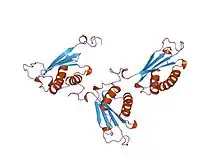| MIF | |||||||||
|---|---|---|---|---|---|---|---|---|---|
 d-dopachrome tautomerase | |||||||||
| Identifiers | |||||||||
| Symbol | MIF | ||||||||
| Pfam | PF01187 | ||||||||
| Pfam clan | CL0082 | ||||||||
| InterPro | IPR001398 | ||||||||
| SMART | MIF4G | ||||||||
| PROSITE | PDOC00892 | ||||||||
| SCOP2 | 1mif / SCOPe / SUPFAM | ||||||||
| |||||||||
Macrophage migration inhibitory factor domain is an evolutionary conserved protein domain.
Macrophage migration inhibitory factor (MIF) is a key regulatory cytokine within innate and adaptive immune responses, capable of promoting and modulating the magnitude of the response.[1] MIF is released from T-cells and macrophages, and acts within the neuroendocrine system. MIF is capable of tautomerase activity, although its biological function has not been fully characterised. It is induced by glucocorticoid and is capable of overriding the anti-inflammatory actions of glucocorticoid.[2] MIF regulates cytokine secretion and the expression of receptors involved in the immune response. It can be taken up into target cells in order to interact with intracellular signalling molecules, inhibiting p53 function, and/or activating components of the mitogen-activated protein kinase and Jun-activation domain-binding protein-1 (Jab-1).[1] MIF has been linked to various inflammatory diseases, such as rheumatoid arthritis and atherosclerosis.[3]
The MIF homologue D-dopachrome tautomerase (EC 4.1.1.84) is involved in detoxification through the conversion of dopaminechrome (and possibly norepinephrinechrome), the toxic quinine product of the neurotransmitter dopamine (and norepinephrine), to an indole derivative that can serve as a precursor to neuromelanin.[4][5]
Examples
Human genes encoding proteins that contain this domain include DDT and MIF.
References
- 1 2 Donn RP, Ray DW (July 2004). "Macrophage migration inhibitory factor: molecular, cellular and genetic aspects of a key neuroendocrine molecule". J. Endocrinol. 182 (1): 1–9. doi:10.1677/joe.0.1820001. PMID 15225126.
- ↑ Van Molle W, Libert C (December 2005). "How glucocorticoids control their own strength and the balance between pro- and anti-inflammatory mediators". Eur. J. Immunol. 35 (12): 3396–9. doi:10.1002/eji.200535556. PMID 16331703.
- ↑ Morand EF, Leech M, Bernhagen J (May 2006). "MIF: a new cytokine link between rheumatoid arthritis and atherosclerosis". Nat Rev Drug Discov. 5 (5): 399–410. doi:10.1038/nrd2029. PMID 16628200. S2CID 21034906.
- ↑ Matsunaga J, Sinha D, Solano F, Santis C, Wistow G, Hearing V (November 1999). "Macrophage migration inhibitory factor (MIF)--its role in catecholamine metabolism". Cell. Mol. Biol. (Noisy-le-grand). 45 (7): 1035–40. PMID 10644007.
- ↑ Sugimoto H, Taniguchi M, Nakagawa A, Tanaka I, Suzuki M, Nishihira J (March 1999). "Crystal structure of human D-dopachrome tautomerase, a homologue of macrophage migration inhibitory factor, at 1.54 A resolution". Biochemistry. 38 (11): 3268–79. doi:10.1021/bi982184o. PMID 10079069.